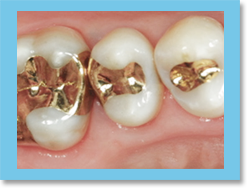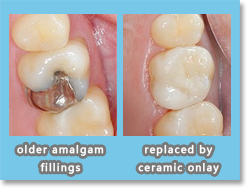Tooth Restoration
Tooth defects because of cavities or trauma, unaesthetic problems related to dental fluorosis or tetracycline teeth, and aiding retention and strength of remaining teeth after RCT, can be fixed by one of the four methods:

Composite Filling
A small cavity involving only one tooth’s surface can be filled with composite, a tooth-colored resin material. It has moderate strength and a natural look.

If the cavity involves two or more teeth surfaces, a composite filling is not the best option because the strength of a composite for large fillings and junctions of the composite and tooth is not satisfactory. So, it is vital that dentist has great filling skill, which may compensate the disadvantages of composites, otherwise the failure rate will increase, leading to food impaction, secondary decay or filling cracks. Inlay/onlay is preferred for complex cavities.

Inlay/Onlay
Inlay/onlay is a solid-casted or milled restoration, involving some occlusal and proximal surfaces cemented into a tooth; onlay covers some occlusal tooth cusp and side wall area. With sufficient strength and excellent junction to tooth, and without the possibility of microleakage caused by the shrinkage of composite over time, inlay/onlay can serve properly in a mouth for tens of years, if maintained well.
Gold inlay/onlay
![]()
For its satisfying strength and ductility, gold is regarded as the best material for inlay/onlay, but offers less aesthetic than ceramic inlay/onlay.

Ceramic inlay/onlay
![]()
Comparing with other materials, ceramics resemble a tooth’s color the most. For its excellent aesthetic appearance and sufficient strength, ceramic inlay/onlay becomes more and more popular.


Crown
A crown is a fabricated, tooth-shaped cover replacement for a missing crown area cemented onto the remaining prepared crown surfaces. A tooth with a large defect or a back tooth after a root canal treatment needs to be restored by a crown to prevent the remaining cusp from being fractured off.


Veneer
Veneer is a thin ceramic layer cemented onto the prepared front tooth. Veneer is mainly used to improve the aesthetic appearance of front teeth with unsatisfying texture or shape. The most attractive advantage of veneer is that the preparation of the tooth’s enamel can be as little as 0.6mm, some cases don’t even need to be prepared because the thinnest veneer can be fabricated up to 0.2-0.3mm. Specific cement with strong bonding strength is used to retain veneer, therefore it is very rare for veneer to fall off, if design, preparation, fabrication and cementation all achieve the international standard. Veneer can save as much of the natural tooth as possible while improving the aesthetic appearance; it is a minimally invasive prosthetic method.

Veneer for Tetracycline Stained Teeth
![]()
Chemically stained teeth, such as the tetracycline brown band line, can be repaired by veneer application.

Veneer for Enamel Fluorosis
![]()
Fluorosis is a condition that can cause molting and discoloration of enamel tissue. The mottled enamel can be covered by aesthetic veneer.

Veneer for Tooth Malformation or Dentural Diastema
![]()
Malformation of front teeth or dentural diastema (the open area between adjacent front teeth) presents an unattractive appearance, but with very little preparation of the related tooth, veneer can restore the normal tooth shape and contact area.
